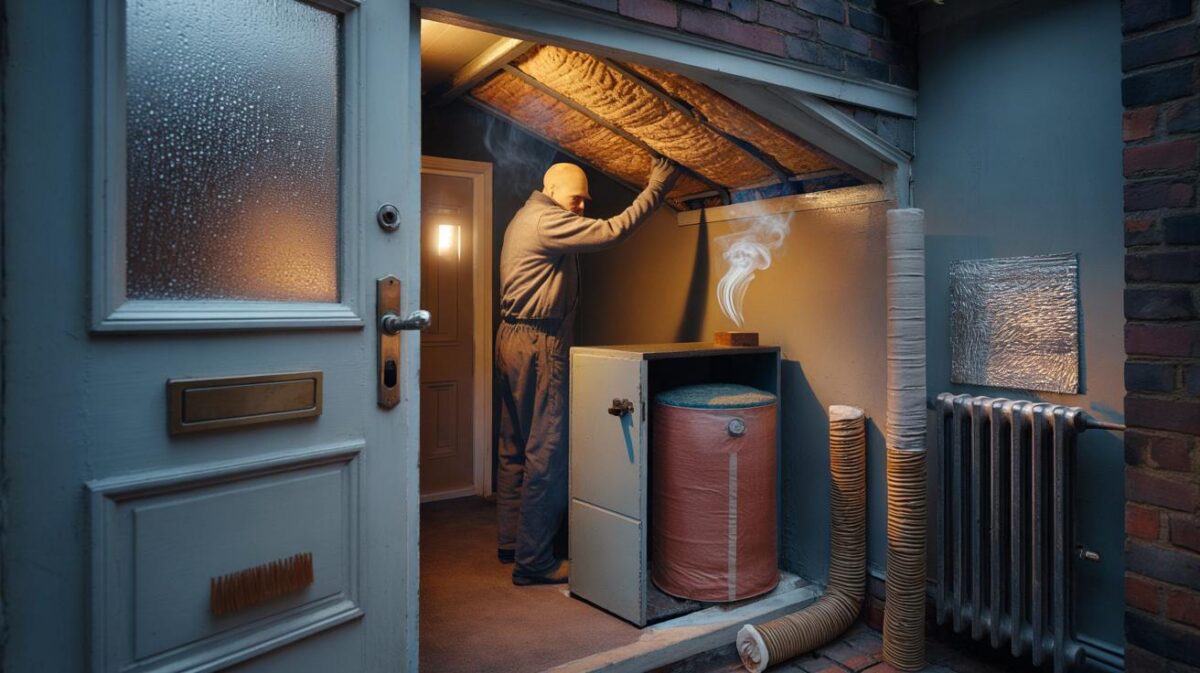Your hands, though, feel tight, a bit fiery, a bit… wrong. The products that blitz grime also strip the skin that holds you together. There’s a gap between what a label promises and what your body pays. If your fingers are cracking or your wrists are itchy, the culprit might be sitting under your sink. Safer ways exist. They’re simpler than you think.
The spray hissed, the citrus hit, and within minutes the kitchen looked magazine-clean. My knuckles told a different story. Tiny white lines, then stinging, then that stiff, drum-skin feeling that turns a simple wash-up into a wince. I clocked the bottle: “antibacterial”, “ultra-degreaser”, “extra strength”. All the words that sound brave and grown-up when you’re facing last night’s pan.
I noticed I was wearing the dirt like a badge anyway: a faint rash in the shape of my watch strap, the pale outline of a ring too sore to wear. The house looked healthier than I did. And that’s the nagging bit. What if the shine hides a cost?
The hidden sting in your sparkling home
Most cleaning formulas are built to do one thing brilliantly: break bonds. Grease from dinner, the mineral veil from hard water, the invisible film of everyday fingerprints. That same dissolving power also unpicks the skin’s barrier — your “brick-and-mortar” wall of fats and cells. Think strong surfactants like SLS, solvents that cut oil, quats that cling and kill.
On tiles and taps, that’s perfect. On hands, it’s a slow leaching of moisture and lipids. *Skin is clever, but chemistry can be louder.* When the balance tips, you get irritation first, then tiny cracks, then a red, itchy map that refuses to settle. The longer it stays, the louder it gets.
During the big disinfecting surge a few years back, GPs quietly saw a rise in sore, split hands from at‑home routines. Patch-test clinics reported fragrance allergy is common in Europe, hovering around a few percent of tested patients, and the preservative MI became a headline allergen before regulations curbed it in leave-on products. At home, the pattern feels familiar: a weekend blitz, a tingling burn, a week of chalky wrists that snag on jumpers.
A friend told me her eczema flared only after she started using a “power foam” bathroom spray. She thought it was stress from work. She swapped to a gentler, fragrance-free cleaner and wore nitrile gloves; within a fortnight, the angry patches softened and the flares spaced out. One switch. One habit. One quiet win you can’t photograph.
To understand why it happens, picture pH. Bleach is alkaline, limescale removers are acidic, and many degreasers ride high on the pH scale to melt oils. Your skin’s sweet spot is mildly acidic. Swing it too far, too often, and the natural enzymes that knit your barrier together struggle. The result is transepidermal water loss — a fancy way of saying you leak moisture and your nerve endings complain.
Fragrance and dyes add another layer. They’re there for the senses, not the cleaning. If you already sit in the dry-skin camp, they can be the nudge from “fine” to “flared”. Even the way we clean adds fuel: hot water softens skin fats, long sessions mean longer contact, and leftover residue on cloths ends up back on your fingers. The clean is real; the collateral is, too.
Kinder habits and smarter swaps that still get it done
Start with the simplest move: cut contact. Slip on snug nitrile gloves for anything stronger than washing-up liquid, then rinse and hang them to dry. Use microfibre cloths with warm water for the daily wipe; they physically lift grime, so you need less chemistry. Choose fragrance-free, dye-free products with plant-based surfactants like alkyl polyglucoside, or dilute liquid castile soap for general surfaces.
For limescale, a citric acid solution tackles kettles and showerheads without the harshness, while a 3% hydrogen peroxide spritz after cleaning adds a disinfecting step for chopping boards and handles. Rinse surfaces your skin touches. Moisturise within five minutes of finishing — a ceramide-rich, no-fragrance cream, not a fancy scented lotion. It locks in water while your skin is still slightly damp.
We’ve all had that moment where the “deep clean” turns into a three-hour saga. Pace it. Shorter sessions mean less skin time in the splash zone. Don’t chase “ultra” or “max” claims for daily jobs. A mild, pH‑neutral floor cleaner is enough for footprints in the hallway. Degreasing the oven? Use a paste of baking soda, leave it to sit, then wipe; save the heavy stuff for true emergencies. **Small tweaks often beat heroic products.**
Common traps are boring to mention and costly to ignore. Mixing products looks efficient on TikTok but creates fumes or off-label reactions — never mix bleach with vinegar or ammonia. Overusing wipes that feel dry means you’re mostly pushing residue around and drying your hands for no gain. Leaving cleaners on skin is a quiet leak: rinsing a cloth, then squeezing it bare-handed, day after day.
Wear gloves when handling laundry powder and decant liquids with a funnel to dodge splashes. Switch to fragrance-free powder for washing, then add oxygen bleach (sodium percarbonate) for whites instead of chlorine bleach. Ventilate. Open the window for real air, not just the extractor. Let the chemistry do its work, then leave your lungs — and your skin — out of the aftermath. Let’s be honest: nobody actually does that every day.
“Your skin isn’t dirty — it’s a living barrier. Clean the kitchen. Don’t strip the human.”
Keep a simple cheat sheet on the fridge so you don’t think in the aisle. **When the decision is easy, your skin wins.** Try this mix-and-match kit:
- Daily surfaces: microfibre + warm water, or diluted castile soap.
- Glass and mirrors: dry microfibre, then a light spritz of water.
- Limescale: 10% citric acid on taps and kettles; avoid natural stone.
- Bathroom disinfect: clean first, then 3% hydrogen peroxide, wipe after contact time.
- Laundry: fragrance-free powder; add sodium percarbonate for brighten-and-sanitise.
- Hands: wash, pat dry, apply a pea-sized amount of ceramide cream.
Your skin, your home, your call
Your house doesn’t need heroics; it needs habit. The swap from “more chemical equals more clean” to “smart tools and mild formulas” feels small the first week and huge by the second. You notice you’re not flinching at hot water. You stop counting tiny splits on your knuckles. The bathroom still gleams.
You may even enjoy the ritual again — the soft drag of a microfibre cloth, the quiet of a window popped open, the quick pump of plain cream as a full stop. **Clean can be calm.** Maybe that’s the bigger point. A tidy home that doesn’t cost you skin or breath is worth a new routine. You’ll know it’s working when you forget what your hands felt like before.
| Point clé | Détail | Intérêt pour le lecteur |
|---|---|---|
| Swap harsh for mild | Use microfibre, APG surfactants, citric acid, peroxide | Reduces irritation without losing cleaning power |
| Protect your barrier | Nitrile gloves, rinse well, moisturise within five minutes | Prevents cracks, sting, and flare-ups |
| Avoid risky combos | Never mix bleach with acids or ammonia; ventilate | Keeps airways and skin safer while cleaning |
FAQ :
- Can I clean effectively without bleach?Yes. Clean first with soap or detergent and water, then use 3% hydrogen peroxide where disinfection matters. Oxygen bleach in laundry handles odours and brightening.
- Which gloves are best for sensitive skin?Nitrile gloves fit closely and are less likely to trigger allergies than latex. Rinse and dry them between uses to reduce residue inside.
- Is vinegar a safe all-rounder?Great for limescale and glass, not for natural stone, aluminium or some rubber seals. Don’t mix with bleach. Keep it as a targeted tool, not a universal spray.
- My hands are cracked from cleaning — what now?Pause fragranced products, wear gloves, wash with a mild, fragrance-free hand wash, and apply a ceramide or urea-based cream morning and night. If it doesn’t settle, speak to a pharmacist or GP.
- What labels help me choose safer products?Look for fragrance-free, dye-free, pH‑neutral cues. Certifications like EU Ecolabel, Nordic Swan or Allergy UK’s Seal can steer you toward milder options.








